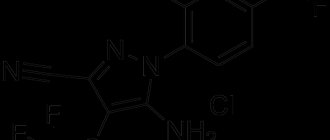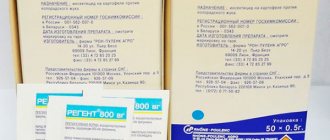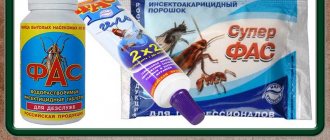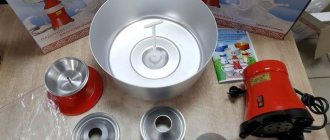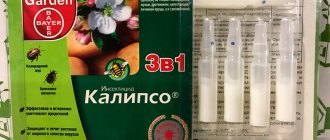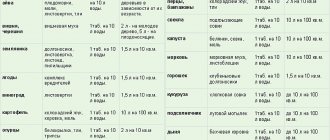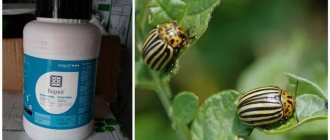Cockroaches have been living side by side with humans for centuries. Until the 18th century, Europe was familiar only with black individuals called Prussians.
Thanks to transit from America, we also got red cockroaches, which significantly displaced their black counterparts.
Red cockroach
These insects don’t look too nice, but that’s far from the worst thing.
They are capable of carrying serious diseases:
- gastroenteritis;
- diarrhea;
- dysentery.
When molting, their chitinous cover is destroyed, its remains cause allergic reactions. It is not easy to remove these insects. You can't do without pesticides here. Many people successfully use Fipronil against cockroaches: a description of the active substance and reviews of drugs based on it will help you choose the right way to fight them.
You may be interested in our other article on the same topic: Where do cockroaches come from in an apartment: how insects choose a home
fipronil: basic information about the pesticide
Description: The insecticide used to control a wide range of pests, including thrips, rootworms, wireworms, weevils and termites.
Year of official registration: 1993
Release of pesticides onto the market (Directive 91/414/EEC), status:
| Status | Annex 1 |
| Speaker/co-speaker dossier | France |
| The enable date is about to expire | 30/09/2017 |
Approved (V) or known (#) in the following European countries:
| V | V | V | V | V | V | V | V | V | V | V |
Also registered in: Australia, USA
Basic information:
| Type of pesticide | Insecticide, Veterinary drug |
| Chemical Structure Group | Phenylpyrazoles |
| Nature of action | Wide spectrum with contact and stomach action. GABA-missing chloride channel antagonist. |
| CAS registration number | 120068-37-3 |
| Code CF (Enzyme Code) | 424-610-5 |
| International Cooperative Pesticide Review Council (CIPAC) code | 581 |
| US Environmental Protection Agency (US EPA) Chemical Code | — |
| Chemical formula | C12H4Cl2F6N4OS |
| SMILES | FC(F)(F)S(=O)c2c(C#N)nn(c1c(Cl)cc(cc1Cl)C(F)(F)F)c2N |
| International Chemical Identifier (InChI) | InChI=1/C12H4Cl2F6N4OS/c13-5-1-4(11(15,16)17)2-6(14)8(5)24-10(22)9(7(3-21)23-24) 26(25)12(18,19)20/h1-2H,22H2 |
| Structural formula | |
| Molecular weight (g/mol) | 437.15 |
| IUPAC name | 5-amino-1-(2,6-dichloro-α,α,α-trifluoro-p-tolyl)-4-trifluoromethylsulfinylpyrazole-3-carbonitrile |
| CAS name | 5-amino-1-[2,6-dichloro-4-(trifluoromethyl)phenyl]-4-[(trifluoromethyl)sulfinyl]-1H-pyrazole-3-carbonitrile |
| Other information | — |
| Herbicide resistance according to HRAC | Not determined |
| Insecticide resistance according to IRAC | 2B |
| Fungicide resistance according to FRAC | Not determined |
| Physical state | White powder |
Release:
| Index | Meaning | |||
| Pesticide Manufacturers |
| |||
| Commercial names of drugs containing a.v. |
| |||
| Associated with this substance: | — | |||
| Assessing the risk of a pesticide to the local environment (England) | No | |||
| Preparative form and application features | Often supplied as fine granules that are dissolved in water and used as a compost treatment or starter. | |||
Popular remedies for cockroaches with Fipronil
Despite the fact that Fipronil was invented in France, at the moment the largest German concern BASF is the holder of full patent rights to manufacture and sell products in Russia and many other countries.
In different countries, Fipronil-based insecticides can be found under the following names:
- Gel against cockroaches "Hector";
- Regent;
- Goliath;
- Termidor;
- Combat Ant-Rid;
- Baron.
Quite a few products are available in the form of gels: Domovoy Proshka, Kapkan; Combat Super gel, Eslanadez.
Let's talk about some of them in more detail.
Gel bait against cockroaches "Hector"
Gel bait (syringe) "Gektor" has a fipronil concentration of 0.05% in its composition! This gel can quickly exterminate pests such as cockroaches. Self-treatment of a room with gel is a big blow for all cockroaches and does not create inconvenience in the form of an unpleasant odor or wet surfaces as after the work of exterminators. The long-term effect of the gel makes it impossible for newborn insects to survive.
The gel is considered effective until it dries completely! In rooms with high humidity, the gel retains its properties much longer!
Hector gel can attract cockroaches within a radius of up to 1 meter. No matter what the insect ate before, it will definitely eat this toxic gel.
After the cockroach is poisoned, it will be able to penetrate the nest of its fellow tribesmen and infect them there. When contacting infected cockroaches, their healthy “relatives” can also become infected.
You can simply lightly touch the cockroach with Hector gel to infect it. Infected insects cannot expand their species. As a result, the entire group of cockroaches will die out.
Gel against cockroaches "Hector"
The Hector gel treatment method for cockroaches is as follows:
- First, remove the cap from the syringe tip;
- Then press the tip of the syringe onto the surface to be treated;
- Gently squeeze a small amount of gel, no more than 1 ml, onto the surface. (the size of a small “drop”);
- The consumption should be 4 drops per square meter;
- After use, wash your hands thoroughly with soap and water.
When processing, pay attention to the following areas:
- Along and inside the baseboards;
- Behind the door panels;
- The back surface of cabinets, refrigerators, stoves;
- Gaps between shelves and walls;
- In ventilation;
- Behind the sink;
- Under the bath;
- Areas behind and under furniture;
- Near the trash container;
- Behind the peeled wallpaper.
Spray Baron
This product is available in the form of bottles with a volume of 100 ml.
Spray Baron against cockroaches
Active ingredient - Fipronil has a concentration of 0.3%. This is quite a bit, but quite enough to effectively kill insects.
After treatment, even a large colony of cockroaches will die within a week.
Places where cockroaches can hide in the kitchen
The can is convenient to use. Spraying is carried out from a distance of 20-25 cm from the surface to be treated.
The areas where cockroaches most often accumulate are sprayed most thoroughly:
- under and behind the kitchen stove;
- along the perimeter at the bottom of the refrigerator;
- under the sink;
- where the trash can is located;
- next to the microwave;
- under the bathtub and sink;
- next to the ventilation holes and inspection hatch;
- baseboards in the hallway;
- in the area of the entrance door along its entire perimeter, including platbands.
Sometimes a single treatment is enough, but to get the result for sure, it is better to repeat the procedure after one or two weeks, this will kill the young individuals that hatched during this time.
To kill cockroaches in an apartment of 50 square meters, just one can of Baron is enough.
You may also be interested in our other article: Where do cockroaches hide, what places in the apartment should you pay close attention to?
Regent
This insecticide is produced by French.
One package contains 0.5 g of water-dispersible, i.e. water-soluble granules.
Packaging of the drug Regent
One bottle contains 100 g of the drug. The concentration of Fipronil is 800 g per kilogram of the drug.
Initially, the product was intended to destroy Colorado potato beetles. As it turned out, it also copes well with cockroaches.
If there is a large concentration of insects, prepare a concentrated solution, for which one sachet of the product is diluted in 250 ml of water. For preventive treatments, it is enough to dilute the bag in 2 liters of water.
This substance has a second class of hazard to humans, so precautions when working with it must be very strict.
- Animals and children are removed from the apartment.
- Use a respirator and safety glasses.
- Wear thick clothing and gloves on your hands.
After treating the apartment, you cannot stay in it for 3 hours. All this time the windows must be open.
A mandatory stage of processing is final wet cleaning using a salt solution.
This effective drug has several undeniable advantages:
- economical consumption;
- no odor;
- safety for the interior - it does not damage wallpaper or upholstery.
Gel Eslanadez
This domestic product in the form of a gel is very convenient to use.
It successfully combines 2 effective insecticides:
- Fipronil at a concentration of 0.03%;
- Imidacloprid at a concentration of 0.5%.
In addition to them, the composition includes gelling agents, a preservative and stabilizer, and sugar. The bitter substance Bitrix, specially included in the composition, will not be to the taste of pets, this will protect them from poisoning.
The gel has an intestinal-contact effect, guaranteeing effective destruction of insects.
Eslandez gel
The protection period is very long - up to 2 months. It is gratifying to note that the gel has only a 4th class of hazard for humans and is considered a low-hazard substance.
The product is available in the form of a syringe containing from 20 to 50 ml of gel. Tubes with a convenient tip contain from 30 to 75 g of the substance.
The gel is a colorless and sometimes white substance, which may have a yellowish tint. Due to its sugar content, the gel is very attractive to cockroaches.
Imidacloprid and Fipronil against cockroaches in the form of a gel are used as follows.
- They clean thoroughly, leaving not a crumb of food behind.
- Squeeze out a thin layer of gel 2 cm long in the form of a dotted line in places where insects accumulate.
- If there are few of them, the distance between the gel strips can be 4 cm. If there are a large number of cockroaches, this can be reduced.
- It is allowed to apply the product to the substrate.
It is especially convenient for use in places that are not accessible to other processing methods.
You can reapply the gel after 2 weeks. This is usually not necessary, since the mortality rate of insects from Eslanadez gel is very high - up to 95%.
Review: Eslanadez anti-cockroach gel, how to use and how effective the drug is
Conclusion
The fight against cockroaches is quite difficult, especially if there is a constant source of their possible appearance - living in a neighboring apartment or the presence of a catering establishment in the house.
In this case, not only immediate actions to destroy insects are important, but also constant prevention of their appearance. Correctly selected and effective Fipronil-based products will help you cope with the problem.
fipronil: behavior in the environment
| Index | Meaning | Source / Qualitative indicators / Other information | Explanation | |
| Solubility in water at 20oC (mg/l) | 3.78 | A5 | Short | |
| Solubility in organic solvents at 20oC (mg/l) | 28 | A5 - Hexane | — | |
| 3000 | A5 - Toluene | — | ||
| 137500 | A5 - Methanol | — | ||
| 545900 | A5 - Acetone | — | ||
| Melting point (oC) | 203 | A5 | — | |
| Boiling point (oC) | Decomposes to a boil | A5 | — | |
| Decomposition temperature (oC) | 230 | A5 | — | |
| Flash point (oC) | Fire hazard is not high | A5 | — | |
| Partition coefficient in the octanol/water system at pH 7, 20oC | P: | 5.62 X 1003 | Calculated | — |
| Log P: | 3.75 | A5 | High | |
| Specific Gravity (g/ml) / Specific Gravity | 1.71 | A5 | — | |
| Dissociation constant (pKa) at 25oC | Not determined | A5 | — | |
| Note: does not dissociate | ||||
| Vapor pressure at 25oC (MPa) | 0.002 | A5 | Volatile | |
| Henry's law constant at 25oC (Pa*m3/mol) | 2.31 X 10-04 | A5 | Not volatile | |
| Henry's law constant at 20oC (dimensionless) | 1.60 X 10-07 | Q2 | Not volatile | |
| Decay period in soil (days) | DT50 (typical) | 142 | A5 | Stable |
| DT50 (laboratory at 20oC): | 142 | A5 | Stable | |
| DT50 (field): | 65 | A5 | Medium stable | |
| DT90 (laboratory at 20oC): | — | — | — | |
| DT90 (field): | — | — | — | |
| Note: | According to laboratory studies of the European Union, DT50 is 32-346 days, geometric mean 142, in field conditions range 5.6-135 days 4 European sites; Other sources: 96 days (DW4) | |||
| Aqueous photolysis DT50 (days) at pH 7 | Meaning: | 0.33 | B5 | Fast |
| Note: | Rapid in artificial light | |||
| Aqueous hydrolysis DT50 (days) at 20oC and pH 7 | Meaning: | Stable | A5 | Very resistant |
| Note: | Stable at pH 5 to 7, some hydrolysis occurs at pH 9 - DT50 approximately 11 days at oC | |||
| Water deposition DT50 (days) | 68 | A5 | Medium fast | |
| Only aqueous phase DT50 (days) | 54 | A5 | Stable | |
| Potential leaching index GUS | 2.67 | Calculated | Transition state | |
| Index of increase in concentration in groundwater SCI (µg/l) at an application dose of 1 kg/ha (l/ha) | Meaning: | 2.09 X 10-01 | Calculated | — |
| Note: | — | |||
| Potential for particle bound transport index | — | Calculated | Average | |
| Koc - organic carbon partition coefficient (ml/g) | 577 | B5 | Poorly mobile | |
| pH stability: No | ||||
| Note: EU dossier range 427-727, 5 soil mL/g; Other sources: 838 mL/g (DW4) | ||||
| Freundlich adsorption isotherm | Kf: | 11.85 | A5 | — |
| 1/n: | 0.95 | — | ||
| Note | Mean of 5 Meanings. Sandy loam OC=0.34% pH=6.1 Kf=4.19; Loam OC=4.25 pH=6.9 Kf=20.7; Loamy sand OC=3.35% pH=6.3 Kf=14.3; Clay loam OC=1.4% pH=6.3 Kf=10.03 | |||
| Maximum UV absorption (l/(mol*cm)) | [3nm=48385; 6nm=7281, 1nm=6008] | A5 | — | |
The main products of pesticide decomposition:
| Metabolite | Education environment | Estimated maximum fraction distribution | Compliance with Directive 91/414 | |
| fipronil amide (Ref: RPA 200766) | the soil | 0.384 | main decomposition product, corresponds to | |
| fipronil sulfone (Ref: MB-46136) | the soil | 0.343 | main decomposition product, corresponds to | |
| fipronil sulfide (Ref: MB-45950) | the soil | 0.170 | main decomposition product, corresponds to | |
Other known pesticide degradation products:
| Decomposition product name and link | Other names | Educational environment/level | Estimated maximum fraction distribution |
| 5-amino-1-(2,6-dichloro-alpha,alpha,alpha-trifluoro-p-tolyl)-1H-pyrazole-3-carbonitrile (Ref: MB 45897) | — | Rat | — |
| 5-amino-1-(2,6-dichloro-alpha,alpha,alpha-trifluoro-p-tolyl)-4-trifluoro-methylpyrazole-3-carbonitrile (Ref: MB 46513) | — | soil (Photolysis, Aerobic); Water; Plant | — |
| Note: Low mobility | |||
| 5-amino-3-cyano-1-(2,6-dichloro-4-trifluoromethylphenyl) pyrazole-4-sulfonic acid, potassium (Ref: RPA 104615) | — | soil (Photolysis); Plant | — |
| Note: Rat oral LD50 > 2000 mg/kg bw | |||
| 1-(2,6-dichloro-4-trifluoromethylphenyl)-3-amino-5-amino-4-trifluoromethylsulfonylpyrazole (Ref: RPA 105048) | — | Water | — |
| Note: Rat oral LD50 467 mg/kg bw | |||
| 5-amino-3-carbamyl-1-(2,6-dichloro-4-trifluoromethylphenyl)-4-rifluoromethylsulfonylpyrazole (Ref: RPA 105320) | — | Plant | — |
| Note: Rat oral LD50 > 2000 mg/kg bw | |||
| 5-amino-1-(2,6-dichloro-4-trifluoromethylphenyl)-4-trifluoromethylsulfonylpyrazole-3-carboxylic acid (Ref: RPA 200761) | — | soil (Aerobic); Plant | — |
| Note: Resistant |
Fipronil contamination of eggs, 2022[edit]
Main article: Fipronil contamination of eggs 2022
The 2022 fipronil egg contamination is an incident in Europe and South Korea involving the spread of eggs and egg products contaminated with insecticides. Chicken eggs have been found to contain fipronil and are distributed in 15 European Union countries, Switzerland and Hong Kong. [34] [35] It is believed that around 700,000 eggs were put on the shelves in the UK alone. [36] Eggs from 44 farms in Taiwan were also found to have excessive levels of fipronil. [37]
fipronil: ecotoxicity
| Index | Meaning | Source / Qualitative indicators / Other information | Explanation | |
| Bioconcentration factor | BCF: | 321 | A5 All fish | Threshold for concern |
| CT50 (days): | 3 | — | ||
| Bioaccumulation potential | — | Calculated | Moderately | |
| Mammals - Acute oral LD50 (mg/kg) | 92 | B5 Rat | High | |
| Mammals - Short-term food NOEL | (mg/kg): | 0.35 | A5 Rat | High |
| (ppm food): | — | — | ||
| Birds - Acute LD50 (mg/kg) | 11.3 | B5 Virginia quail | High | |
| Birds - Acute toxicity (CK50 / LD50) | — | — | — | |
| Fish – Acute 96 hour CK50 (mg/l) | 0.248 | A5 Rainbow trout | Moderately | |
| Fish - Chronic 21 day NOEC (mg/l) | 0.015 | A5 Rainbow trout | — | |
| Aquatic invertebrates - Acute 48 hour EC50 (mg/l) | 0.19 | B5 Daphnia magna (Daphnia major, Large water flea) | Moderately | |
| Aquatic Invertebrates - Chronic 21 day NOEC (mg/L) | 0.068 | A5 Daphnia magna (Daphnia major, Large water flea) | — | |
| Aquatic crustaceans - Acute 96 hour CK50 (mg/l) | 0.00014 | A5 Mysis shrimp | High | |
| Bottom microorganisms - Acute 96 hour CK50 (mg/l) | — | — | — | |
| Bottom microorganisms - Chronic 28 day NOEC, static, Water (mg/l) | 0.0001 | A5 Chironomus mosquito | High | |
| Benthic microorganisms - Chronic 28 day NOEC, Sediment (mg/kg) | 0.0002 | A5 Chironomus mosquito | High | |
| Aquatic plants - Acute 7 day EC50, biomass (mg/l) | 0.16 | A5 Duckweed | Moderately | |
| Algae - Acute 72 hour EC50, growth (mg/l) | 0.068 | A5 Green algae (Scenedesmus subspicatus) | Moderately | |
| Algae - Chronic 96 hour NOEC, growth (mg/l) | — | — | — | |
| Bees - Acute 48 hour LD50 (µg/individual) | 0.00417 | B5 Oral | High | |
| Soil worms - Acute 14-day CK50 (mg/kg) | > 500 | A5 Earthworm , corr | Moderately | |
| Soil Worms - Chronic 14-Day Maximum Non-Effective Concentration, Reproduction (mg/kg) | 500 | A5 Earthworm , corr | Short | |
| Other soil macroorganisms, such as springtails | LR50 / EC50 / NOEC / Action (%) | 0.32 | A5 Tropical white springtail (Folsomia candida) , EC50 Reproduction mg/kg | — |
| Other Arthropods (1) | LR50 (g/ha): | 0.01 | 48 hour A5 Rider (imago) | Harmfulness at 1 kg/ha |
| Action (%): | — | — | — | |
| Other Arthropods (2) | LR50 (g/ha): | 0.101 | Day 7 A5 Predatory mite | Harmfulness at 1 kg/ha |
| Action (%): | — | — | — | |
| Soil microorganisms | Nitrogen mineralization: no significant effect Carbon mineralization: no significant effect | A5 [Dose: 0.67 mg/ha soil, 28 days] | — | |
| Available data on the mesoworld (mesocosm) | NOEAEC mg/l: | — | — | — |
| NOEAEC mg/l: | — | — | — | |
Side effects
Fipronil has low (grade 2) dermal toxicity and moderate (grade 3) oral and inhalation toxicity. When applying the drug to the dermis, short-term skin reactions may occur: redness, itching, rashes, loss of fur at the site of application.
If the drug enters the intestines, symptoms of neurotoxic damage may occur:
- tremor of the limbs;
- vomit;
- increased salivation;
- convulsions;
- abnormal gait;
- depression;
- increased nervousness;
- hunched over.
The same signs may appear when Fipronil is inhaled if the spray is handled carelessly. In case of severe poisoning, lethargy, convulsions and death of the animal may occur. It has been found that dogs are more sensitive to the substance than cats.
An overdose can also provoke an allergic reaction, breathing problems, and heart palpitations. Symptoms of poisoning can be eliminated by administering barbiturates.
fipronil: human health
Basic indicators:
| Index | Meaning | Source / Qualitative indicators / Other information | Explanation | |
| Mammals - Acute oral LD50 (mg/kg) | 92 | B5 Rat | High | |
| Mammals - Skin LD50 (mg/kg body weight) | 354 | A5 Rabbit | — | |
| Mammals - Inhalation CK50 (mg/l) | 0.36 | A5 Rat | — | |
| ADI - permissible daily dose (mg/kg body weight per day) | 0.0002 | A5 Dog, SF=100 | — | |
| ARfD - average daily intake (mg/kg body weight per day) | 0.009 | A5 Rat, SF=100 | — | |
| AOEL - acceptable systemic operator exposure level | 0.0035 | A5 Dog, SF=100 | — | |
| Skin absorption (%) | 1.0 | A5 | — | |
| Hazardous Substances Directive 76/464/EC | List II | — | — | |
| Types of restrictions | — | — | — | |
| by category | Are common: | |||
| Professional: | ||||
| Examples of European MRLs (mg/kg) | Meaning: | Maize, sunflower grains and sweetcorn: 0.05 | ||
| Note: | [A5 EU dossier proposals] | |||
| MPC in drinking water (µg/l) | — | — | — | |
Toxicological and hygienic characteristics:
| ? | ? | — | X | V | — | V | V | — |
| Effect on humans | [Thyroid, kidney and liver poison], [Very toxic], [Bioaccumulates] | |||||||
V: Yes, it is known what causes it X: No, it is known what does not cause it? : Possibly, not exactly determined - : No data
Legislation:
| Index | Meaning | Source / Qualitative indicators / Other information | Explanation | ||||
| Basics | [Doesn't explode], | ||||||
| European Commission Risk Classification | , | ||||||
| European Commission safety classification | S1/2, S28, S36/37, S45, S60, S61 | ||||||
| WHO classification | II | — | Moderately dangerous | ||||
| US Environmental Protection Agency (US EPA) classification | II | — | Warning— | ||||
| UN Number | 2588 | ||||||
| Packaging and disposal | [Usually packaged in Group III (minor hazard) containers] | ||||||
Action
Fipronil is a neurotoxin (nerve poison) of intestinal and contact action. In animals, it binds to γ-aminobutyric acid (GABA), the most important mediator (regulator) of the passage of nerve impulses through the chlorion channels of nerve cell membranes. Without the mediator “turned off” by fipronil, the nervous system becomes overexcited to the point of convulsions, followed by a reaction - paralysis and death.
The specific mechanisms of transmission of nerve impulses to muscles in different groups of animals are significantly different. Fipronil is quite highly selective against insects, incl. resistant to carbamates, pyrethroids and FOS. However, the objects of elimination develop tolerance to this substance, therefore, in agricultural technology, pesticides with fipronil are used in rotation to avoid resistance of pests or occasionally during their mass invasion. In the fight against resistance, fipronil is used as a replacement drug, because actively accumulates in plants, and moves along the soil profile slowly and to a depth of no more than 30 cm.
The speed of action of fipronil as an agrotechnical insecticide is low - the death of insects begins 8-10 hours after treatment. The effectiveness is also not 100% - after a day, up to 15% of pests survive. However, the protective effect is long-lasting, 14 days or more, and the drug is not washed off by rain. Therefore, on land areas, fipronil is most effective against massively migrating pests: when the density of individuals and the total volume of the wandering mass decreases below a certain limit, it stops migrating, and the surviving individuals scatter across the area and, “not feeling the shoulder of their fellows,” quickly die, leaving no offspring, like ants isolated from an anthill.
Note : Since 2003, fipronil has been recommended by the FAO (Food and Agriculture Organization of the United Nations) as the primary control agent for desert locust infestations.
Insecticide "Brownie Proshka"
Gel "Proshka Domovoy" showed high efficiency
This product may seem unsightly, and it is not at all advertised. But it is worth noting that the drug is domestically produced, comes in a convenient gel form, and contains a high percentage of such an effective substance as fipronil against cockroaches. By purchasing this gel, you already receive a ready-made bait, which you only need to apply at home to the expected places of movement of pests.
“Domovoy Proshka” has many advantages: it contains the effective component fipronil, the product is convenient to distribute and apply, has a low cost, but is of good quality. But when working with any insecticides, do not forget about the rules of personal safety.
Fipronil is a toxic substance that is included in many effective drugs for killing various household pests. Due to its high toxicity, the drug cannot be used to treat rooms where children or pets live. Often, if you work carelessly with fipronil, a person experiences headaches, nausea, dizziness and skin irritation.
Instructions for use
Fipronil is included in a variety of drugs, each of which has its own purpose, so there are no universal instructions for it - in each specific case you must follow the instructions provided by the manufacturer. The only condition common to all drugs is compliance with standard safety measures:
- While working with the substance, drinking, smoking and eating are prohibited. The face should be protected with a special mask, hands with gloves, and body with tight-fitting clothing to prevent the drug from coming into contact with exposed skin.
Take precautions when treating with Fipronil to avoid poisoning - The dishes that were used to prepare the working solution should not subsequently be mixed with kitchen utensils.
- Fipronil should not be used near ponds or aquariums. During treatment, there should be no small children or pregnant women nearby. If the drug is used as part of a food bait, the latter is positioned so that the child cannot reach it.
- At the slightest symptoms of poisoning (dizziness, nausea, vomiting, general weakness, etc.), you should immediately consult a doctor.
Anti-flea products with Fipronil are contraindicated for puppies and kittens under two months of age, as well as adult animals with weakened immune systems.
The substance has the first and third classes of danger for pollinating insects (depending on the purpose of the drug, which includes Fipronil). Hazard classes for humans - second and third.
Reviews from owners and veterinarians
Ekaterina, 45 years old, Murmansk: “A cat and a dog live in my apartment. Bobik and I often walk in the forest belt and go into nature, so we need a strong anti-tick remedy. Marusya stays at home, but she can become infected with insects from the dog.
Instead of drops, I decided to try Fipronil spray. It is not only effective, but also economical. For 2 adult animals, a 250 ml bottle is enough for 4 treatments.”
Vladimir, 32 years old, Moscow region: “I live in my own house. That's why my 2 cats roam freely around the yard. Last year it was a hot summer and the fleas were overwhelming. I had to look for a good, reliable product with a prolonged effect.
At first I bought Fipronil drops, but the seller recommended a spray. There is much more of it and you can treat your pets during the entire period of flea and tick activity. I bought a 100 ml container. There’s even left for next year.”
Olga, 23 years old, Nikolaev: “3 kittens were dropped off at my place of work. We took them home. The babies were heavily infested with fleas. I washed them with special shampoos, tar soap, and combed them. But after a while they appeared again.
On the advice of the veterinarian, I dropped a few drops of Fipronil onto the withers. The kitten was approximately 2-3 months old. I watched the reaction for 24 hours, but everything turned out okay. But I didn’t see any more fleas.”
Kaleria, veterinarian, Tambov: “I use insecticides with fipronil myself to treat pets and recommend them to my clients. If you follow the rules of use, the product is safe, effective and relatively inexpensive.”
Sergey, veterinarian, Vladimir: “For fleas and ticks, I recommend Fipronil spray. It is capable of killing adult parasites and their larvae. The spray is convenient to use for treating cat beds, but after that they need to be thoroughly ventilated and fried in the sun. I recommend testing for an allergic reaction before use so that you don’t have to treat your pet later.”
